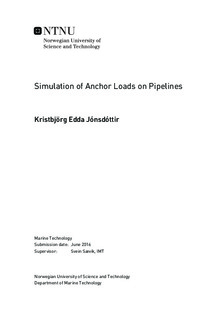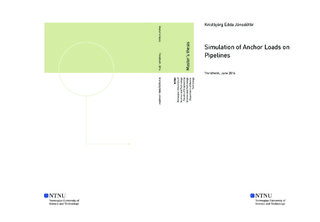| dc.description.abstract | Incidents where anchor and pipeline interact are rare, but such an event can have drastic consequences. In the report, "Pipeline and Riser Loss of Containment" by HSE, published in 2001 for the UK sector, 44 incidents involving anchors and pipelines were found for the period 1990-2000. Furthermore, The International Cable Protection Committee reported that between 2007-2008, there were ten cases of submarine cables damaged due to anchor damage. All of these cases were due to vessels being unaware of their anchors being deployed during transit.
The objective of this thesis is to study the anchor s and the pipeline s response to such interactions. The response of the anchor was investigated by performing a parametric study and categorizing the anchor s behaviour. The pipeline was modelled as a 10 meter long constrained rigid body in this study. The literature usually defines anchor behaviour as impact, hooking or pull over. In this study a new system was made for the categorization of the behaviour. The behaviour was either categorized as brief or lasting contact. If categorized as brief, the contact was further defined as either pull over or bounce over. If lasting contact, it was defined either as hooking or sliding, with or without twisting.
Seventy-eight models were analysed in the parametric study. The parameters investigated were the anchor s mass and geometry, towing speed of the anchor, size of pipeline and angle of attack between anchor and pipeline. Forty-eight new models were created to investigate the minimum chain length for the towed anchor to reach the subsea pipeline. A constant water depth of 200 meters was applied in all studies.
The pipeline s global response was studied by performing eleven case studies. The parameters applied in these cases were based on the results from the parametric study and the minimum chain length study. In the eleven cases studied, the pipeline was modelled to be 10 kilometer long, with elastoplastic material properties. The pipeline was constrained at the ends, but otherwise allowed to displace and globally deform. The effect of the interaction on the pipeline was investigated by studying the longitudinal strains in the cross-section. The results were compared with DNV s design load strain for combined loading, and with the pipeline s characteristic strain resistance.
The study of minimum chain length revealed that for an anchor towed at 2 knots, a chain length approximately 3 meters longer than the water depth was required. For the 10 knot case, due to drag forces, the chain needed to be roughly 110 meters longer than the water depth. However, these results are only valid when the anchor is dropped 100 meters away from the pipeline.
The general trend of the anchor behaviour seen in the parametric study, points towards an increase in hooking and sliding with increased mass of anchor, smaller pipe diameter and lower vessel speed. The largest amount of hooking scenarios in the parametric study occurred for 60 degrees angle of attack, as the anchor twisted and hooked. No hooking occurred for the 30 degrees cases, while all sliding events occurred for this angle.
Three of the eleven case studies resulted in hooking. In all of these cases, the longitudinal strain in the cross-section of the pipeline exceeded both DNV s design load criteria for combined loading and the pipeline s characteristic strain resistance. Exceeding the characteristic strain resistance puts the integrity of the structure at risk for local buckling. However, a more detailed FEA is necessary to determine the actual response of the cross-section, and which failure mechanisms it may initiate.
In the case studies with the full-length pipeline, no hooking was obtained for the attack angle of 60 degrees, which contradicts the results from the parametric study. This may indicate that the rigid modelling of the pipeline, rather than the anchor s response, caused the hooking response in the parametric study.
The three of the eleven case studies that resulted in hooking, revealed that the global displacement of the pipeline is much greater when the anchor is towed at a lower velocity. For higher velocities, the hooking case with minimum chain length displaced the pipeline farther, both laterally and vertically, than the anchor towed with maximum chain length. | |

